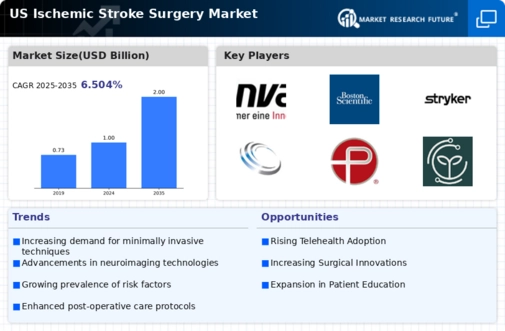Growing Aging Population
The increasing aging population in the US is a critical driver for the ischemic stroke-surgery market. As individuals age, the risk of ischemic strokes escalates, leading to a higher demand for surgical interventions. According to the US Census Bureau, by 2030, all baby boomers will be over 65 years old, significantly increasing the prevalence of age-related health issues, including strokes. This demographic shift suggests that healthcare systems must adapt to accommodate the rising number of patients requiring surgical treatment for ischemic strokes. The ischemic stroke-surgery market is likely to experience substantial growth as healthcare providers enhance their capabilities to manage this growing patient population effectively.
Rising Healthcare Expenditure
The rising healthcare expenditure in the US is a significant factor influencing the ischemic stroke-surgery market. As healthcare spending continues to increase, more resources are allocated to advanced medical technologies and surgical procedures. According to the Centers for Medicare & Medicaid Services, national health expenditure is projected to grow at an average rate of 5.4% annually, reaching approximately $6.2 trillion by 2028. This financial commitment allows for the development and implementation of cutting-edge surgical techniques and technologies, which are essential for improving patient outcomes in ischemic stroke cases. Consequently, the market is likely to benefit from this trend as healthcare facilities invest in better surgical options.
Increased Awareness and Education
There is a growing awareness of stroke symptoms and the importance of timely intervention, which is positively impacting the ischemic stroke-surgery market. Public health campaigns and educational initiatives have been instrumental in informing the population about stroke risks and the need for immediate medical attention. This heightened awareness leads to earlier diagnosis and treatment, ultimately increasing the number of patients undergoing surgical procedures for ischemic strokes. The American Stroke Association reports that timely treatment can significantly improve outcomes, which may further encourage individuals to seek medical help promptly, thereby driving the market.
Advancements in Surgical Techniques
Innovations in surgical techniques are transforming the landscape of the ischemic stroke-surgery market. Minimally invasive procedures, such as endovascular thrombectomy, have shown promising results in improving patient outcomes. Studies indicate that these techniques can reduce recovery times and hospital stays, making them more appealing to both patients and healthcare providers. The introduction of advanced imaging technologies, such as intraoperative MRI, further enhances the precision of surgical interventions. As these advancements continue to evolve, they are expected to drive the demand for ischemic stroke surgeries, as healthcare professionals seek to provide the best possible care for their patients.
Regulatory Support for Innovative Treatments
Regulatory support for innovative treatments is emerging as a vital driver in the ischemic stroke-surgery market. The US Food and Drug Administration (FDA) has been actively streamlining the approval process for new surgical devices and techniques, which encourages innovation in the field. This regulatory environment fosters the development of novel therapies that can enhance surgical outcomes for ischemic stroke patients. As new technologies receive faster approvals, healthcare providers are more likely to adopt these innovations, thereby expanding the market. The ongoing collaboration between regulatory bodies and medical professionals is likely to yield further advancements, ultimately benefiting patients in need of surgical intervention.






















Leave a Comment